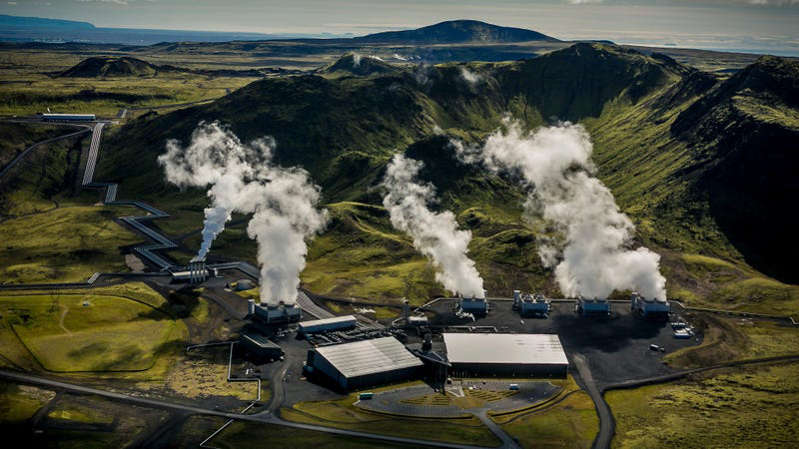Hellisheidi Geothermal Park in Iceland. The Orca DAC plant has come online at this location.
The world’s biggest direct air capture (DAC) plant is set to come online in Iceland on Wednesday. The moment is an important one in developing new technologies to help suck carbon dioxide out of the air—but raises a whole host of questions on the future of how we’re going to put those technologies to use.
The Orca plant, located about 20 miles (30 kilometers) southeast of the capital of Reykjavík, uses large industrial vacuums to remove carbon dioxide from the air. The plant’s owners and operators, a Swiss startup called Climeworks, said that the plant can remove 4,000 metric tons of carbon dioxide per year from the atmosphere, powered by hydrothermal energy. Climeworks has partnered with a carbon storage company to take that carbon dioxide and store it deep underground, where it turns into stone (whoa) after about two years.
Unlike other carbon capture technologies that prevent carbon dioxide from being released from dirty technologies in the first place—which are generally attached to fossil fuel facilities—DAC plants like Orca present the possibility of removing some of the damage we’ve already done. In theory, we could dot the earth with plants like Orca, resulting in what are known as “negative emissions.” These types of technology aren’t ready for primetime at scale yet, but the Intergovernmental Panel on Climate Change has said we need them to help meet the target of limiting global warming to 2 degrees Celsius (3.6 degrees Fahrenheit) outlined in the Paris Agreement (in addition to cutting emissions in the first place of course).
“This is a big step forward in enabling us to capture carbon dioxide that’s already been emitted to the air and store it permanently and safely,” David Morrow, the Director of Research at the Institute for Carbon Removal Law and Policy at American University, said in an email. “That’s going to be an important supplement to emissions reductions in stabilizing the climate. … Orca is still small compared to the scale of the challenge, but it’s an important step in the right direction.”
Carbon capture, including DAC techniques, is incredibly expensive, and Climeworks is running a pretty straightforward business model to pay for it: Get businesses and other entities with climate goals to buy their services directly. Climeworks already has some high-profile partners invested in the Orca plant. In a release on the Climeworks website, a Microsoft representative is quoted as calling the technology “a key component of our carbon removal efforts,” while insurance giant Swiss Re has also entered an agreement with the company to help with meet its net-zero goal.
Smaller businesses, as well as individuals like you and me, can also buy the opportunity to have some of our carbon sucked out of the air (minus the substantial PR benefits that companies get, of course). A section of the website allows users to pick a subscription plan for carbon dioxide removal, ranging from $8 to $55 per month, with links to testimonials from “climate-positive people”—aka people who have already paid for the Climeworks service.

© Photo: Julia Dunlop A closeup of a Climeworks direct air capture plant.
If the Orca plant delivers on its promise, it would, as E&E calculated, bump up the world’s existing direct air capture by more than 40%, and would allow humanity to suck 13,000 metric tons of carbon dioxide from the air each year. Sounds great! But there’s an important part of context behind those impressive-sounding numbers: 13,000 metric tons of carbon dioxide is less than 1% of the yearly emissions from a single coal plant. (The 4,000 metric tons the Orca plant will capture is less than the yearly emissions from just 800 cars.)
And scaling these technologies up to actually make a difference will be challenging. “It’s hard to know how costs will actually evolve,” Morrow said. He pointed out that the Orca facility is actually made up of a bunch of small DAC units, and Climeworks is focused on figuring out how to make these smaller units cheaper; other companies, meanwhile, are looking at constructing DAC technologies on larger, industrial-level scales. Both Climeworks and its leading DAC competitor, Carbon Engineering, are focused on pulling carbon dioxide out of the air at a cost of $100/ton—not exactly cheap given the world emitted more than 35 billion tons of carbon dioxide in 2019. Even with cuts to emissions, the cost of relying heavily on DAC to keep the planet from burning up is still steep.
“There are a handful of new companies developing other technologies and promising costs well below $100/ton, but we’ll hard to know how much faith to put in those promises,” Morrow said.
These numbers are a reminder of the stark reality of these types of technologies: Despite the world’s billionaires, tech companies, and huge corporations getting jazzed about DAC and other promising carbon capture technologies, they’ve still got a lot to prove in terms of scalability and price. Plants like Orca are also incredibly energy intensive and would need a lot of additional renewable capacity to make them a true net positive for the climate.
And there’s also a huge question of whether these new technologies will serve as distractions from the larger, harder task of decarbonizing the economy by allowing businesses to keep polluting as long as they can pay for it. After the Biden administration earmarked more than $8 billion for various carbon capture technologies in the infrastructure bill, a large international coalition of green groups, businesses, and environmental justice organizations sent a letter in July to the administration expressing “deep concerns” over the U.S.’s support of these technologies.
Still, the Orca plant won’t stay the world’s largest DAC facility for long. Canadian company Carbon Engineering is building a facility in Scotland that will capture between 500,000 and 1 million metric tons of carbon dioxide. The company is aiming for it to be operational by 2026. Oil company Occidental is also partnering with Carbon Engineering to build a DAC plant in the Permian Basin that could remove up to 1 million metric tons of carbon dioxide per year. (Occidental has said that the captured carbon dioxide would be fed back underground and used to—what else?—pump even more oil.)
“The most important thing to know about carbon removal, in general, is that it’s not a replacement for cutting emissions,” Morrow said. “It is an important supplement to cutting emissions, but not a replacement. … DAC will get cheaper, of course, but so will renewable energy and other ways of cutting emissions.”








